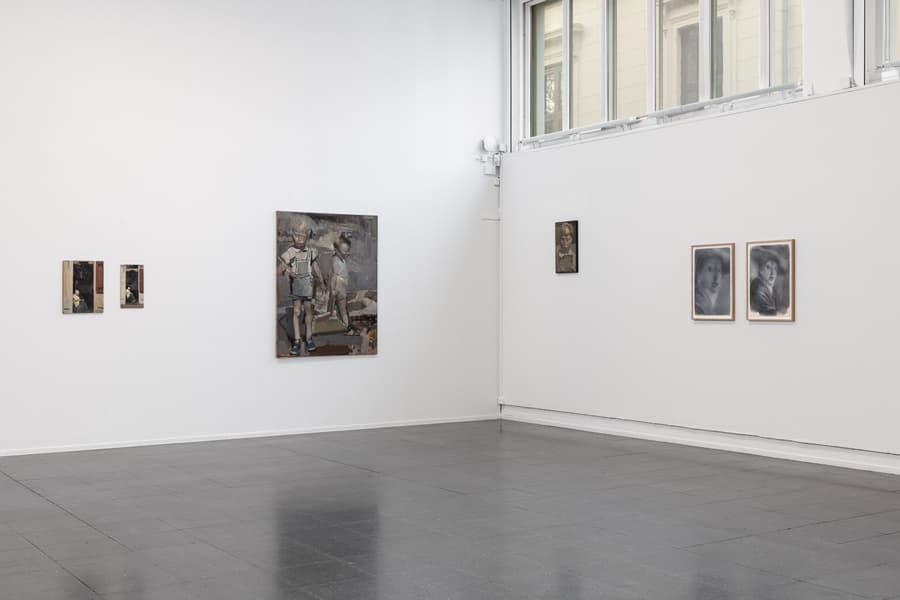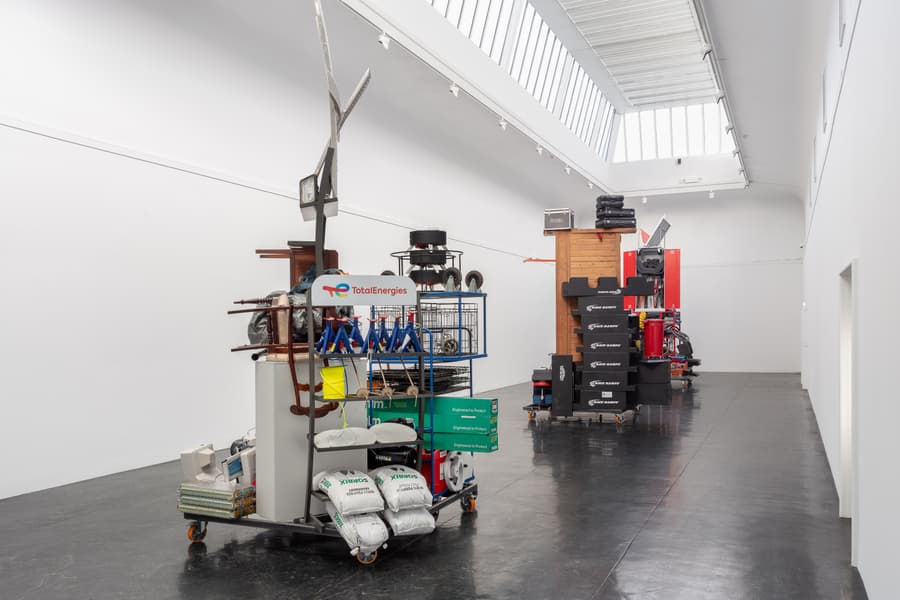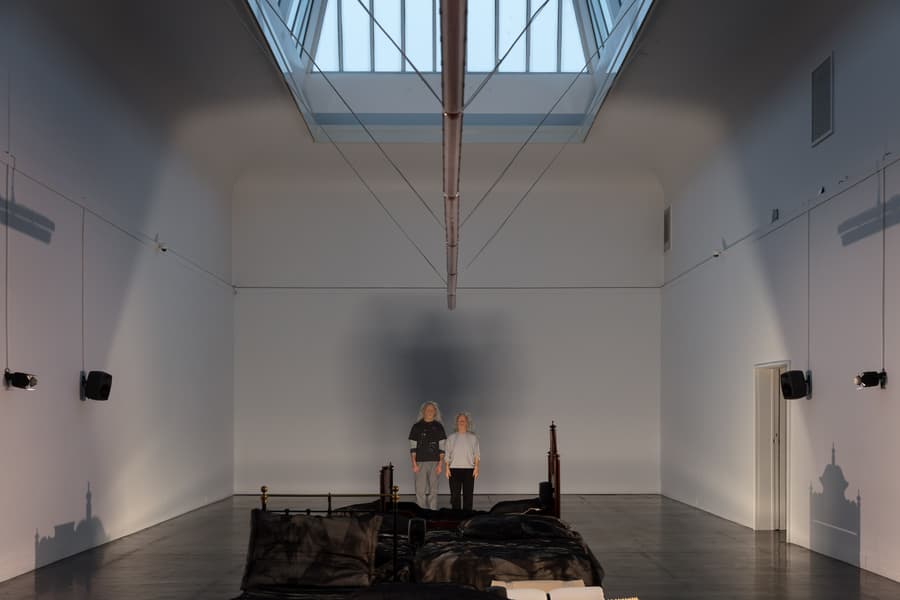50 års Jubileumsutstilling

Catalog text
JUBILARE NECESSE EST, ...
We chose to celebrate in May, — the spring festival month. With Gunnar Sønstevold's cheerful musical arrangement in Slottsparken and Wergelandsveien, we begin the celebration of our fiftieth year. At the same time as we open the doors for the big anniversary exhibition, we can put the book about Kunstnernes Hus on the counter and, in this two-sided way, shed light on the business over half a century.
When we welcome you to this exhibition, it is also an invitation to a walk through the history of modern art. By placing the exhibition in the daylight hours from May until the end of August, when schools start again, we hope that the public in Oslo and those who travel around the capital during the holidays will have the opportunity to go through the exhibition several times. In other words, it is not exclusively out of jubilee desire and celebration that we choose May, knowing that it was in the autumn of 1930 that Kunstnernes Hus began its activities. Naturally enough with the Autumn Exhibition, which must be said to be the real origin of the House.
If the building is 50 years old, the history of the House is about twice as old. It was preceded by the artists' farewell to the Art Association, the establishment of the artists' own exhibition, which eventually received public support, became the National Art Exhibition and is today the most popular art gathering in the Nordics. With rented and often unsuitable showrooms, the idea of owning a house arose. We know with what fervor the artists went in to realize the dream, nearly fifty years of collections, auctions, lotteries, carnivals, bodegas; enough anecdote-creating years to fill a book as thick as a Bible. Above all, Christian Krohg stands as the Moses who led the artists to the promised land. Like the prophet, he did not experience the fulfillment of his dream, but could go to his grave confident that it would be realized.
Another of the pioneers got to experience it; Erik Werenskiold was the guest of honor at the inauguration of the House in 1930. In his speech he mentioned the word quality, and asked the question whether one would be able to fill these large halls with good exhibitions.
Looking back, and we do so on this occasion, over a thousand exhibitions have been shown in the House. Naturally enough, not everything has been of the greatest art, for it is now the case that there are not many geniuses at any given time, and they do not grow on trees, even in this country. But the House has provided exhibition opportunities so that we have seen talents in growth, and at times could reflect a vibrant and contrasting national art life.
The house has also seen it as its task to open the doors to large-format international exhibitions. 1 In the 1930s, Huset was probably the only exhibition venue that was able to properly show major representative exhibitions of contemporary art. At the same time as these glimpses into world art, Kunstnernes Hus has on certain occasions been the scene of the event when a Norwegian artist breaks through for the first time with works of art that make us see in a new way, works of art that we believe will stand for judgment of the centuries.
This judgment of the future is of course difficult to predict, just as we cannot create a valid stamp of quality at all times. With the human urge for absolutes, we sometimes find the eternal truths, also in the visual arts. For one's own part and one's own art, it can probably be a strength with the fervor of conviction to advocate certain artistic principles. In the service of art communication, such a view that only sees quality within its own circles will be impossible. The house's task must be to direct the light towards several circles, in the recognition that in art there are many truths and new ones are constantly being born, which is precisely the art life of our century is an example of. Quality is often the stamp of recognition. It may turn out to be the quality of the moment, and will be a bad guideline for an artist-led dissemination institution.
Kunstnernes Hus should not only be an open house for already recognized art. You have to actively go out to the unstamped, unestablished art, what is under way, and inspire to exhibit here. If we also manage to bring in international art - something that offers a big financial boost -, we will achieve what we want: a living art centre.
We also see that new forms of exhibition are becoming necessary. The most important thing that has taken place in Norway's art life in recent times is perhaps not the art that can be hung on the walls and that is usually displayed in the exhibition halls, but the new signals from public culture. front, an expected cultural upgrade also in the visual arts area within artist education, visual arts in the districts and increased use of art to decorate public buildings and environments. Here, too, Huset finds it important to be involved, with new exhibition forms to shed light on the new tasks of the visual arts.
We want to avoid jubilee shaming, but it should be mentioned that during the initial preparations for the commemoration of the jubilee, doubts have repeatedly been raised about the legitimacy of such an event. In recent years, Kunstnernes Hus's finances have been so tight that a lavish anniversary celebration would come to stand in stark contrast to the possibilities the institution has to carry out meaningful art dissemination. When we have nevertheless taken the decision to carry out the large and expensive event in this way, it is both to mark that for half a century the Artists' House has been an indispensable institution in our artistic life and to emphasize the necessity that the Artists' House as the most important part of the artist-led dissemination is given opportunities to follow up in the future.
In the end, all financial concerns notwithstanding, we believe that a grand anniversary is necessary. Then the preface's title, which might have been perceived as a joke, nevertheless takes on a serious meaning: Jubilare necesse est, ...!
The exhibition, which is based on works of art previously exhibited in the House, has been made possible after friendly hospitality with loans from a number of public and private collections in Norway and abroad, and with financial support from the Norwegian Culture Council, from foreign embassies and cultural institutions.
The management thanks them, and all those who have otherwise contributed to realizing the event.
Thorstein Rittun, Chairman of the Board















































